President's Message
Fellow Members
Earlier this year we had a presentation on wooden bicycles by Mauro Hernandez and Bill Holloway of Masterworks. I thought that their bikes were fantastic machines, good for cruising up and down the Santa Cruz boardwalk if that is your thing, but not for real biking - they were a bit steampunkish. Then a few weeks ago Per told me about a place in Sausalito called Renovo Bicycles that sells "real" wooden bikes. The kind of bicycle that if someone rode past and you did not look closely you would think it was just another standard metal bike.
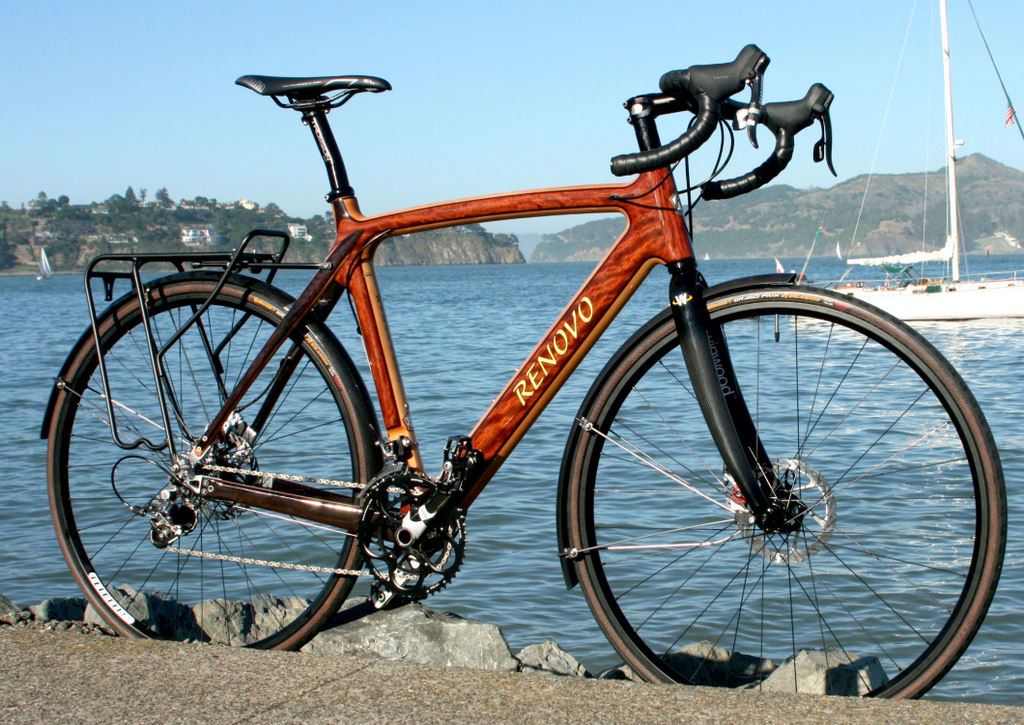
Renovo bicycles are based around lightweight hollow wooden bicycle frames. They list many advantages of using wood that we do not normally come across in our day-to-day woodworking including: wood absorbs vibration better than steel, aluminum or carbon; the fatigue life of wood exceeds steel or aluminum, and approaches carbon; wood is not susceptible to crack propagation from dents like the metals; wood is as stiff pound for pound as the metals.
They describe the frames as a "sublime blend of high-tech magic and fine craftsmanship".
The bicycles are made in a wide range of wood combinations including Figured Purpleheart over White Ash, Walnut, Yellowheart, with Padauke and Black Walnut combined with Port Orford Cedar. Great looking combinations. All of these are popular woods that we use in our workshops.
They point out on the website that wood has been used for mechanical vehicles for over a century. The World War ll De Havilland Mosquito fighter/bomber was made of Birch Plywood over a Balsa frame. The famous Spruce Goose airplane was made of - Spruce. They also have pictures of many old wooden bicycles on their website. The oldest was made in the Netherlands in 1820!
After CNC cutting the smooth shape of the frames is achieved by hand finishing. Apparently they found that woodworkers and cabinet makers could not do this work. They do not have the eye for the shapes they say, so they use artists.
The custom made frames are $1,950 to $3,800 - better prices than you can get for making kitchen cabinets!
You can see the video of them making the frames: renovobikes.com/renovo-videos/
Enjoy your woodworking.
Frank
Frankramsay8@aol.com
The meeting was called to order by President Frank Ramsay punctually at 7AM.
New Members and Guests:
The following people introduced themselves:
We had one new member: Josh from Menlo Park. Josh has just started in his woodwork and builds basically what his wife wants him to build.
Announcements:
Per gave details of the remainder of this year's calendar:
Next month we have a presentation by BAWA's own John Blackmore who will be talking about joints for chairs and other things he learnt while attending a course at the College of the Redwoods this summer.
In October we have the 3rd annual BAWA woodworking show.
In November there is the Annual meeting and election of Directors and Officers plus our Annual Jigs & Fixtures demonstrations and Box Contest
In December we will have our annual Hors D'oeuvres/Dessert Potluck with Members Show and Tell and Christmas ornament contest.
Guest speaker will be Loy Martin - well established studio furniture maker from Palo Alto
Stan showed the current raffle wood which consists of several maple boards valued at $99 plus the night's assortment of door prizes including a special magnetic band that allows you to hold your car wheel changing brace on your arm while you walk round a supermarket or anywhere else.
Frank reminded everyone about our 3rd Annual Show taking place at Woodcraft, San Carlos on the weekend of 19/20/21 October.
Special show postcards are available and members are encouraged to take as many as they need to pass them on to friends, family, colleagues and leave them in any suitable supply shops etc in their area.
It is time to starting planning your exhibits for this year show. Logistical details of this year show will be announced next month.
Finishing Fine Furniture

Ted talked about his past mentioning that he first graduated with music degrees and then progressed to restoring pianos before he started his own cabinet business. He took the finishing/restoring courses that were available and worked with commercial spray finishes for 10 years until the vapors and other nasty stuff got to him. He now mostly uses hand applied finishes - they give good results and are better for your health.
Today finishes are available that are easy to apply yourself without special equipment, mostly shellac or varnishes, and can you get good results after 1 or 2 attempts.
Ted had a lot of questions from our members about different finishes and solvents. During the course of the presentation he passed around several boards finished with various combinations of sealers and finishes to illustrate his talk. Below is a compressed summary of some of his main points.
While answering one question about thinning and/or mixing finishes he replied:
"You can mix anything and it will go right or you can mix anything at it will go wrong"
ie: you need to test every step of your process.
Notes
The chemistry of finishes. There are two main types:
Finishes that cure i.e. Polymerize and change their chemistry when they cure
Finishes that evaporate such as shellac and lacquer which can be reworked and repaired (r since no matter how many layers you apply you end up with effectively 1 layer of finish
Tips
You always need to test your finish process on scrap wood first.
Shellac
Shellac acts as a barrier for anything and should be used in most cases as a sealer coat on bare wood before any other finish and/or a seal coat and over any dye or stain.
Ted is using shellac more and more: "The most pleasurable of finishes"
Shellac was the West's response (European) to Asian lacquers.
Coloring wood:
Oil based wood needs to be stabilized first so color stays in the filler.
Color wood with Japanese color or any oil based color.
Can use shellac but it takes longer to dry than lacquer. Shellac takes at least a day for the alcohol to fully evaporate.
Staining with a gelcoat is very easy, good for opaque stains.
Ted prefers dyes over stain as dyes do not make the wood opaque like a gelcoat.
An old school finishing rule is to build up a finish with gloss on gloss and add the final sheen at the end.
This provides a good sheen and allows the wood to show through. If you build up a finish with layer upon layer of a satin finish you obscure the wood.
Gloss finish is not something to attempt in a workshop as there is too much dust/contaminants.
Alcohol absorbs water and is only good for about 1 year even in its can so do not buy gallon tins unless you use a lot. The older stuff is still good for tasks like brush cleaning. Like many products buy good stuff.
Many of the solvents sold by the cheaper chain stores are made from recycled material and may contain traces of oil that you do not want on your project.
If you get a finish cracking it is a separating of the layers
Open pored wood not good with oil finishes as they sink in too far and take a long time to dry.
Soft wood is a closed pored wood.
French polish: Hard to manipulate. Takes a long time to dry. Trick is to spraying sanding sealer first. Skips about 15 layers of French polish. Spray 50/50 mineral spirits and oil to wet the pad.
Use sanding sealer for regular lacquer.
Teak is a greasy wood.
For period finishes, either on new products or restoration work, it is important to consider the use of the piece. Using a French polish on a table which is going to be in day to day use is not a good ideaas it marks too easily. Better to use a gelcoat which has a hard surface.
Water based finish is not good for lighter woods.
Thinners are categorized by their aggressiveness: hot to cold, aggressive to not aggressive
List of hot, aggressive thinners to cold non-aggressive thinners:
Lacquer thinner ie: acetone
Naphtha ie: fast paint thinner
(Can be used for removing wax – Liberon steel wool and solvent)
Alcohol
Mineral spirits
Gamsol (Odorless mineral spirits) Used for thinning oil paints
Retarders
Japan Driers is a retarder. Used with urethanes to help drying but contain heavy metals - "a nasty solvent"
You can put cold over hot but not hot over cold as hot may melt the cold
There is a government push to use water based finishes but Ted has not had a good experience with water born anything but has not been looking at the newer water based finishes of the last few years.
Materials
Lacquer: Thinned with lacquer thinners but government trying to phase out due to high VOCs (volatile organic compounds) so trying to use finishes with more environmentally friendly materials. Finishes have 10/20% solids as opposed to epoxy which is 100%.
Mohawk Rapidpad:
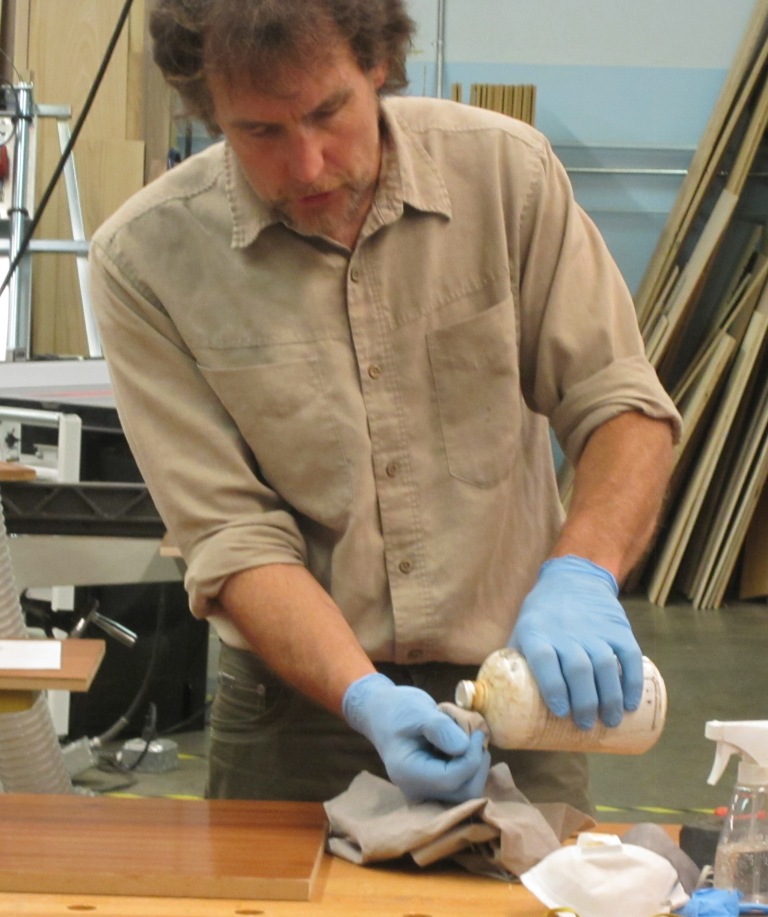
Applying RapidPad
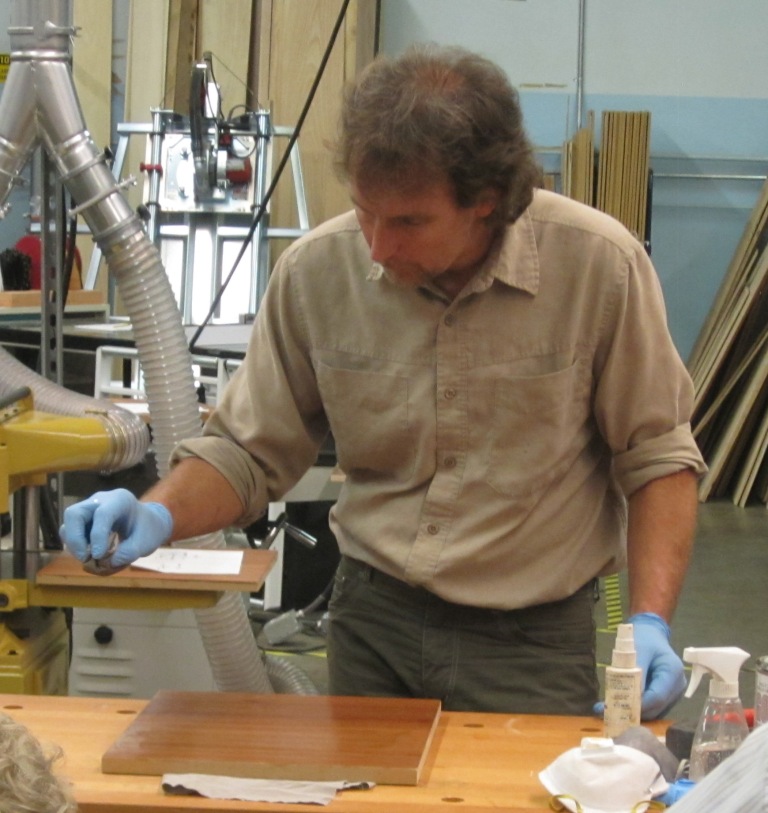
Padding it on
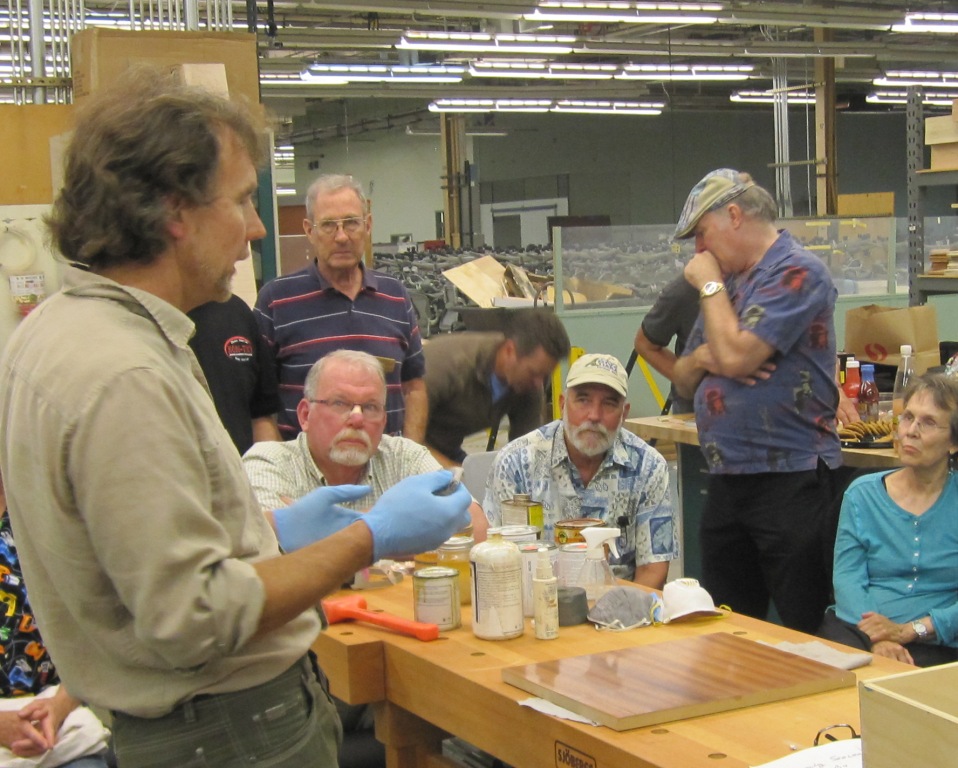
"like a French polish in a can"
Brushes
Best type of brush for varnish: badger hair brush, expensive ($50+) but last a long time and give best results
Foam Brushes are also good. The foam brushes from West Marine are good. Do not spoil a good job with the cheap brushes from places like Home Depot and Lowes.
Zar Quick drying polyurethane: is a good product.
Liberon: good for waxes and shellac.
Epifines (a supplier of yacht finishes): Good varnish for matt or satin - use interior/exterior matt
Good Stuff: Gel urethane give a great finish
You can get good materials at suppliers like:
West Marine
City Paints San Francisco (7th /Howard)
Sherwin Williams: has a great lacquer thinner
Don't use Home Depot/ Lowes etc (quality not as good as the specialist suppliers)
Seal coat:
Sealer shellac is 2lb cut wax free (normal Zinsser shellac is 3lb cut)
Oil sealer sinks in more and can show grain more if that is the effect you want.
Don't use Home Depot/ Lowes etc (quality not as good as the specialist suppliers)
Can get better stuff at West Marine as yacht requirements have some exemptions to the tight VOC requirements.
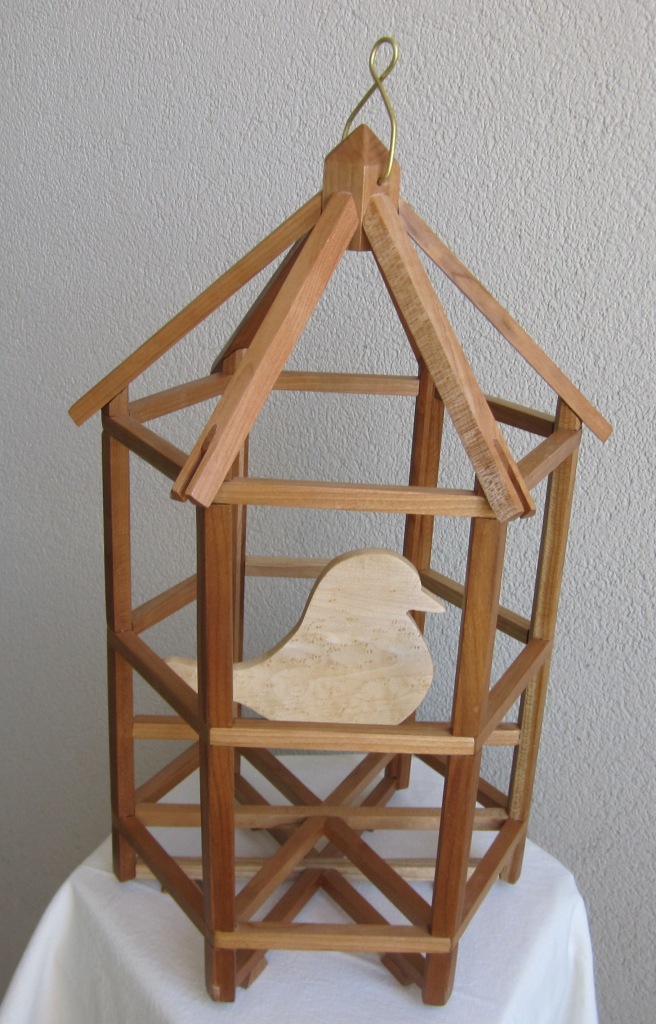
Caged Bird
Frank Ramsay showed an ornamental bird cage complete with caged bird. The cage was made from 3/8 in square cherry. It had 3 way Chinese style lap joints for the base layers and the side bars were half lap joints onto the 5 sided uprights. The technical challenge had been to cut all of the joints on a 10in bladed table saw. (Frank uses a SawStop and would not feel comfortable making anything this small on a conventional table saw)
The bird as cut from a piece of 1/4in thick piece of figured Maple.
Dan Goodman, Frank Ramsay, Stephen Rosenblum steve@rosenblums.us
